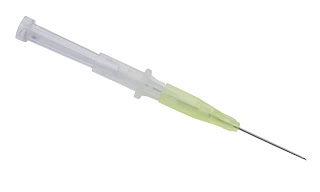IV Cannula Vs Safety IV cannula

Introduction An IV Cannula (Intravenous cannula) is a small plastic tube, inserted into a vein, usually in hand or arm to provide fluids when you are dehydrated, give a blood transfusion administer medications directly into your bloodstream. Some drugs work better this directly injected into our veins. These cannulas are available in various gauges (16–24 gauge), lengths (25–44 mm), compositions, and designs. IV Cannulas are used for Repeated blood sampling., IV transmission of fluid, medications, chemotherapeutic agents, nutritional support, blood/blood products, radiologic contrast agents for computed tomography (CT), magnetic resonance imaging (MRI), or nuclear imaging. Need of Safety IV Cannula Since the cannula punctures the skin, there is always a risk of infection and developing complications such as hematoma, embolism and phlebitis. Healthcare providers must take precautions to prevent the same. According to the World Health Organization, close to 80% of all hospital




